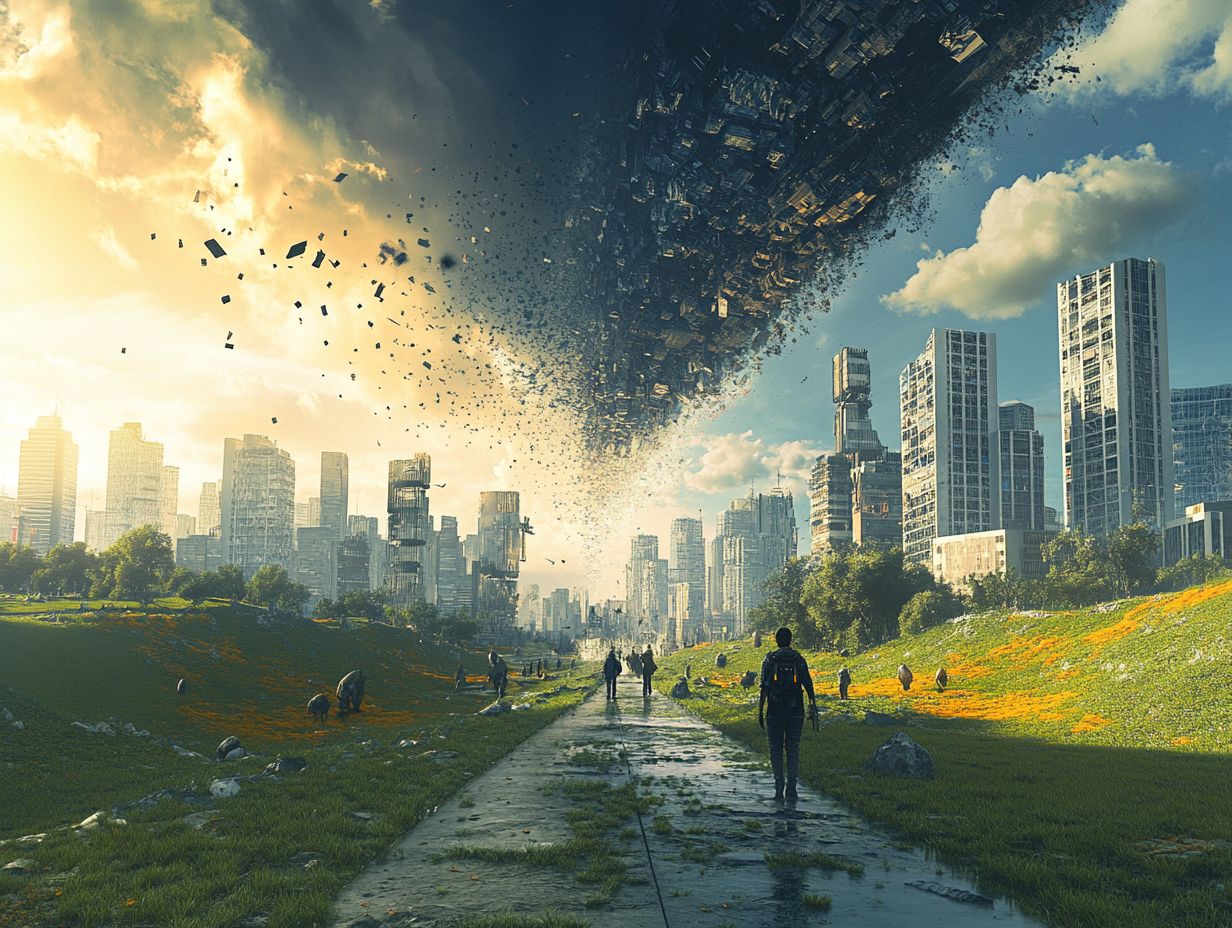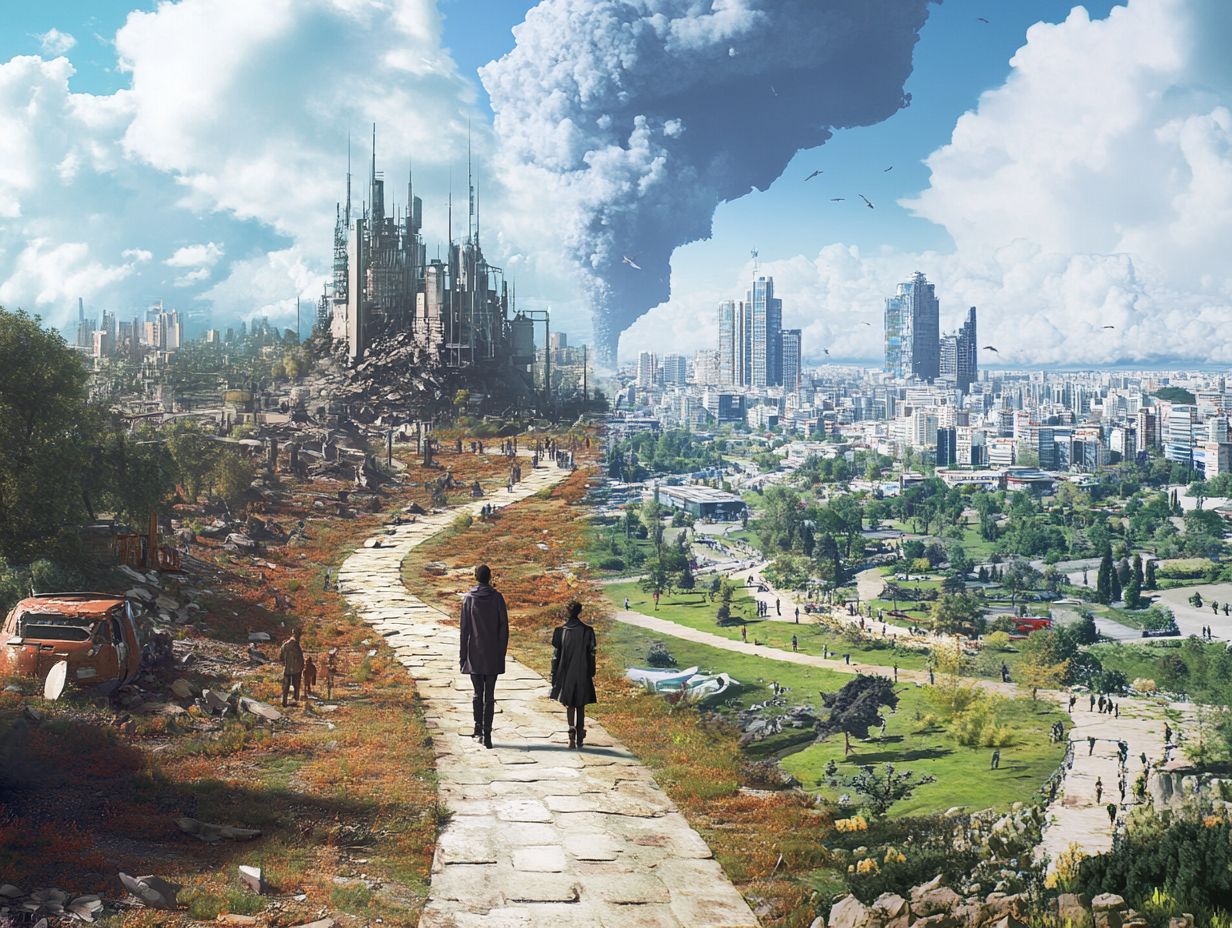Dystopian fiction encompasses storytelling in film, television, or literature that portrays a bleak future, often reflecting the social and political struggles of contemporary society.
The most memorable dystopian novels and films serve as cautionary tales, compelling us to confront the way we live today.
This article defines the term “dystopia,” lists and briefly describes some of the most significant works within the genre, and draws parallels between the fictional worlds and the real-life struggles we face in society today.
Ultimately, dystopian fiction not only reminds us of our identity and values but also inspires us to envision a better future.
Defining Dystopia

Dystopia refers to a vision of society that has gone awry, particularly one characterized by oppressive societal control and the illusion of a perfect society often maintained through authoritarianism, technology, or other means. In contrast to utopia, dystopia is used in literature as a device to explore the darker sides of the human experience. Dystopian narratives frame important philosophical questions about morality and ethics, with answers that evolve alongside our changing world.
These narratives serve not only as cautionary tales but also as profound social commentaries on our understanding of freedom and justice. Consequently, they play a vital role in sociopolitical discussions surrounding human rights and governance, both in their literary forms and in real-life expressions.
In literature, dystopian societies often depict a reality in which individuality is stripped away and citizens are under constant surveillance, mirroring contemporary anxieties about privacy and authoritarianism. Notable examples include George Orwell’s *1984* and Margaret Atwood’s *The Handmaid’s Tale*, which portray societies reflecting urgent societal issues such as government overreach, gender inequality, and environmental degradation.
By illustrating societies where technological progress has overshadowed human welfare, dystopian narratives encourage readers to consider both individually and collectively the state of the world today and the potential consequences of ignoring pressing social issues. In this way, dystopia serves as both a possible outcome of humanity’s shortcomings and a continual reminder of the challenges we face in the present.
Examples of Dystopian Fiction
Dystopian fiction has captivated audiences through popular novels and films, presenting dark and often chilling portrayals of future societies characterized by oppression, government control, and the consequences of unchecked technological advancement. Notable examples of this genre include *1984* by George Orwell and *The Handmaid’s Tale* by Margaret Atwood.
As the genre has gained popularity, dystopian fiction increasingly reflects societal fears and anxieties surrounding totalitarianism, cultural imperialism, climate change, and artificial intelligence. Consequently, dystopian films and books can be interpreted as cultural critiques that mirror and amplify contemporary concerns about surveillance, inequality, and environmental degradation.
Popular Dystopian Novels and Films

Popular dystopian novels and films, such as “Brave New World,” “The Hunger Games,” and “Blade Runner,” have significantly influenced both literature and cinema. Each of these works uniquely explores various aspects of the human experience within the context of societal degradation and oppression.
They often feature strong character development and well-crafted narratives that facilitate in-depth analysis and discussion of cultural experiences related to themes such as inequality, resistance, and the ethical dilemmas posed by new technologies.
Through a close examination of the characters’ motivations, these stories reveal the challenges individuals face as they make decisions that impact their lives and the lives of others in totalitarian and oppressive settings. The oppressive worlds depicted in these narratives serve as a medium for reflecting on the consequences of such systems, compelling the audience to confront unsettling realities regarding power dynamics and ethical responsibilities.
The meticulous construction of their plots not only entertains but also encourages deeper discussions about human endurance, societal values, and the often blurred lines between freedom and oppression, creating an effect that resonates long after the story concludes.
Real-World Parallels to Dystopian Worlds
The intersection of dystopian fiction and real-world parallels offers a compelling lens through which to explore pressing social and political issues, as well as to underscore the potential consequences of current trends such as government control, surveillance, and climate change.
These narratives remind us of the inequalities present in contemporary society, fostering discussions about human rights and the ethical implications of technological advancements that reflect the very fears portrayed in speculative fiction.
Social and Political Issues

Social and political issues such as inequality, government control, and oppression are central themes of the dystopian genre, reflecting the very real challenges that communities face in their ongoing fight for equality and justice. These themes engage audiences with the complex landscapes surrounding human rights and highlight the necessity of resistance against oppressive regimes, raising awareness about the need for social justice and the collective unification of marginalized voices.
The socio-political challenges depicted in dystopian narratives resonate meaningfully with contemporary struggles against inequality and authoritarianism occurring worldwide. From racial justice movements in North America to youth-led climate initiatives in Europe and pro-democracy uprisings in the Middle East, the current landscape underscores the urgency of collective action.
Just as the apathy of a populace serves as a cautionary theme in dystopian fiction, the real world reminds us that community mobilization is essential for challenging the entrenched status quo and making tangible demands for justice. By galvanizing communities to rise against oppressive regimes or systemic injustice, individuals can drive change and foster the emergence of a more equitable society, emphasizing that the pursuit of justice is not merely a theoretical exercise but an imperative.
Technological Advancements and Ethical Concerns
Dystopian fiction often delves into the ethical issues surrounding topics such as artificial intelligence, surveillance, and the manipulation of information through propaganda. This genre raises concerns about the dangers of technological innovation and highlights the ethical dilemmas that arise when technology intersects with human rights and social justice.
As technological advancements accelerate, readers are compelled to confront the social implications of these innovations in their own lives. They are encouraged to consider the appropriate balance between security and freedom, as well as the risks posed by a society that becomes overly dependent on technology.
Dystopian fiction illustrates how the relentless pursuit of progress can erode individual autonomy and raises critical questions about whether we will engage in the ethical discussions necessary to prevent such scenarios as we shape the future of humanity.
Lessons Learned from Dystopian Fiction

Dystopian fiction imparts important lessons that resonate deeply with the human condition. It offers powerful cautionary tales about the devastating effects of oppression, inequality, and authoritarianism, while also providing hope and inspiration for overcoming these challenges.
This genre equips readers with the tools to engage critically with social commentary, reflecting on the potential dangers of oppressive regimes while advocating for the necessity of resistance. Dystopian narratives often inspire social change and highlight the importance of imagination and innovation in the pursuit of a better world.
Warnings and Cautionary Tales
Warnings and cautionary tales embedded in dystopian literature reveal the darker aspects of human nature and the fragility of social structures, serving as reflections on our power dynamics and the potential for societal collapse. Through dystopian themes, authors frequently explore the existential dread that accompanies the loss of freedom and justice, urging readers to confront uncomfortable truths about human behavior and governance.
For instance, George Orwell’s *1984* serves as a poignant reminder of the dangers of totalitarianism and surveillance, illustrating how a pervasive government can stifle individual thought and foster a culture of fear. Similarly, Aldous Huxley’s *Brave New World* critiques consumerism and the superficial pursuit of happiness, showcasing the consequences of sacrificing genuine human connection for manufactured pleasure.
These narratives compel modern readers to reflect on their own societal structures, the erosion of civil liberties, and the implications of technological advancements, prompting them to consider how easily a society can devolve into repression and complacency.
Inspiration for Change and Action
Dystopian fiction acts as a catalyst for change, inspiring individuals to take action and fostering a sense of hope. These narratives reveal to readers that a better world exists beyond the confines of the fictional setting, and that they possess the power to create it by standing up against injustice and advocating for a society that includes the marginalized. Such works often emphasize the struggles of oppressed individuals, highlighting how they are frequently left to fend for themselves. Themes of rebellion and community action are prevalent in these stories, motivating readers to become advocates for human rights and to pursue systemic changes in their surroundings.
Beyond mere words on a page, dystopian literature inspires real-life action. Stories like *The Hunger Games* and *The Handmaid’s Tale* incorporate elements of rebellion, encouraging readers to believe in the possibility of positive change and motivating them to engage in social movements that promote equity and equality. By depicting rebellion, these narratives showcase the potential for change and inspire readers to initiate similar movements in their own communities, such as the Women’s March, Black Lives Matter, and other grassroots initiatives. Dystopian fiction serves as a reminder that individuals can make a difference; rebellion often leads to hope, a recurring theme that spurs readers to envision a brighter future.
One of the most renowned examples of rebellion intertwined with hope in dystopian literature is found in George Orwell’s *1984*, which illustrates how love and friendship can give the power to individuals to resist oppressive regimes. Similarly, Margaret Atwood’s *The Handmaid’s Tale* portrays the protagonist Offred, who clings to her identity in oppressive circumstances by drawing upon her memories of the past and imagining a better future. In contrast, some stories depict unsuccessful rebellions. Aldous Huxley’s *Brave New World* reveals that society is deliberately structured to promote happiness and quell dissent, ultimately illustrating the despair of the defeated rebels.
These narratives reflect the consequences of the status quo, a common theme in dystopian fiction that often centers on the struggles of marginalized communities. By mirroring the realities faced by these groups, such stories hold significant power for real-world movements. Systemic changes frequently emerge from the authentic struggles of oppressed communities, which dystopian fiction aptly reflects. When the status quo is mirrored in society through these narratives, it resonates deeply with readers, highlighting the power of art and literature to create systems of care, community, and support when the real world falls short.
Storytelling can address systemic failures and lead to tangible change. For instance, Angie Thomas’s *The Hate U Give* deeply connected with many people of color, allowing them to feel seen for the first time and helping them articulate their own struggles with policing, identity, and family—topics they may have previously felt unable to discuss. Dystopian works that reflect the struggles of marginalized communities and the systemic failures of the status quo can galvanize real-world movements for equity and justice.
Prominent examples of dystopian fiction that inspire change and encourage societal movements for equity and justice include:
- George Orwell’s *1984*, which critiques a regime that uses surveillance and war to control its citizens and has inspired movements like Occupy Wall Street
- Suzanne Collins’s *The Hunger Games*, which addresses government oppression and has inspired protests such as the Arab Spring
- Margaret Atwood’s *The Handmaid’s Tale*, which critiques religious fundamentalism and has spurred protests against sexism and gender-based violence, including the Women’s March
- Aldous Huxley’s *Brave New World*, which critiques the misuse of technology and science, inspiring initiatives like the March for Science
These examples vividly illustrate how dystopian fiction can fuel movements and initiatives in the real world. The world portrayed in dystopian narratives often mirrors the experiences of real individuals living under oppressive regimes, and when these struggles are reflected back to readers, they can spark both hope and meaningful action.


